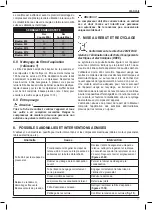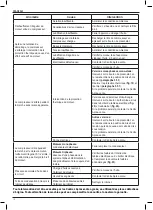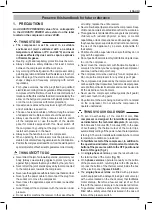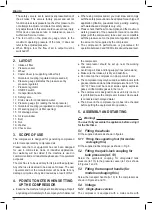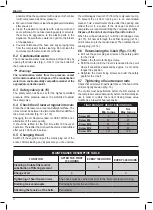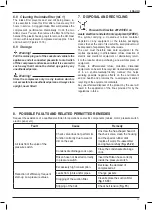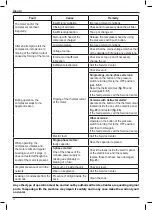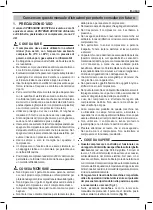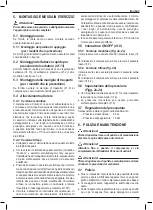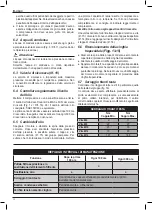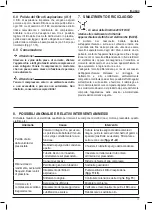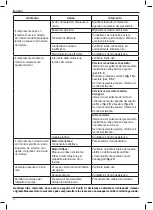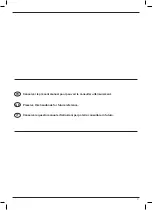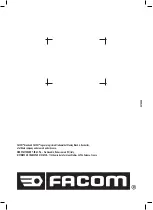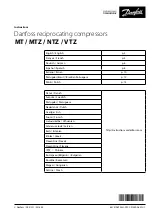
19
ENGLISH
1. PRECAUTIONS
An ACOUSTIC PRESSURE value of 4 m. corresponds
to the ACOUSTIC POWER value stated on the label
located on the compressor, minus 20 dB.
THINGS TO DO
●
The compressor must be used in a suitable
environment (well ventilated with an ambient
temperature of b5°C and +40°C) and never
in places affected by dust, acids, vapors, explosive
or flammable gases.
●
Hearing, sight and respiratory protection must be worn.
●
Always maintain a safety distance of at least 4 meters
between the compressor and the work area.
●
Any coloring of the belt guards of the compressor during
painting operations indicates that the distance is too short.
●
Insert the plug of the electric cable in a socket of suitable
shape, voltage and frequency complying with current
regulations.
● For 3-phase versions, have the plug fitted by a qualified
electrician according to local regulations. When starting the
compressor for the first time, check the correct direction of
rotation and that this matches the direction indicated by the
arrow on the belt guard (versions with plastic protection)
or on the motor (versions with metal protection).
●
Use extension cables with a maximum length of 5 meters
and of suitable cross-section.
●
The use of extension cables of different length and also
of adapters and multiple sockets should be avoided.
●
Always use the switch of the pressure switch to switch
off the compressor or use the switch of the electric
panel for models equipped with this. Never switch off
the compressor by pulling out the plug in order to avoid
restart with pressure in the head.
●
Always use the handle to move the compressor.
●
When operating, the compressor must be placed on a
stable, horizontal surface to guarantee correct lubrication.
●
Position the compressor at least 50 cm from the wall to permit
optimal circulation of fresh air and to guarantee correct cooling.
THINGS
NOT
TO DO
●
Never direct the jet of air towards persons, animals or your
body. (Always wear safety goggles to protect your eyes
against flying objects that may be lifted by the jet of air).
●
Never direct the jet of liquids sprayed by tools connected
to the compressor towards the compressor.
●
Never use the appliance with bare feet or wet hands or feet.
●
Never pull the power cable to disconnect the plug from
the socket or to move the compressor.
●
Never leave the appliance exposed to adverse weather
conditions.
●
Never transport the compressor with the receiver under
pressure.
●
Do not weld or machine the receiver. In the case of faults
or rusting, replace the entire receiver.
●
Never allow inexpert persons to use the compressor. Keep
children and animals at a safe distance from the work area.
●
This appliance is not intended for use by persons (including
children) with reduced physical, sensory or mental
capabilities, or lack of experience and knowledge, unless
they have been given supervision or instruction concerning
the use of the appliance by a person responsible for
their safety.
●
Children should be supervised to ensure that they do not
play with the appliance.
● Do not position flammable or Nylon®/fabric objects close
to or on the compressor.
● Never clean the compressor with flammable liquids or
solvents. Check that you have unplugged the compressor
and clean with a damp cloth only.
●
The compressor must be used only for air compression.
Do not use the compressor for any other type of gas.
●
The compressed air produced by the compressor cannot
not be used for pharmaceutical, food or medical purposes
except after particular treatments and cannot be used to
fill the air bottles of scuba divers.
●
Never use the compressor without guards (belt guard)
and never touch moving parts.
●
Pay attention to the work being carried out. Do not stand
on the compressor. Do not allow the compressor to
operate unattended.
THINGS YOU SHOULD KNOW
●
To avoid overheating of the electric motor,
this
compressor is designed for intermittent operation
as indicated on the technical dataplate
(for example,
S3-50 means 5 minutes ON, 5 minutes OFF). In the case
of overheating, the thermal cutout of the motor trips,
automatically cutting off the power when the temperature
is too high. The motor restarts automatically when normal
temperature conditions are restored.
●
To facilitate restart of the compressor, in addition to
the operations indicated, it is important to return the
button of the pressure switch to the OFF position and
then to ON again (fig. 2).
●
On
single-phase versions
, press the reset button on
the terminal box of the motor (
fig. 19
).
●
On
3-phase versions
, operate manually on the button
of the pressure switch, returning this to the ON position,
or press the button of the thermal cutout inside the box
of the electric panel (
figures 2b & 20
).
●
The
single-phase versions
are fitted with a pressure
switch equipped with a delayed closing air vent valve (or
with a valve located on the check valve) that facilitates
motor start-up; therefore a few-second jet of air from
this, with the reservoir empty, is to be considered normal.
●
To guarantee machine safety, all the compressors are
fitted with a safety valve that is activated in the case of
failure of the pressure switch.
Preserve this handbook for future reference













